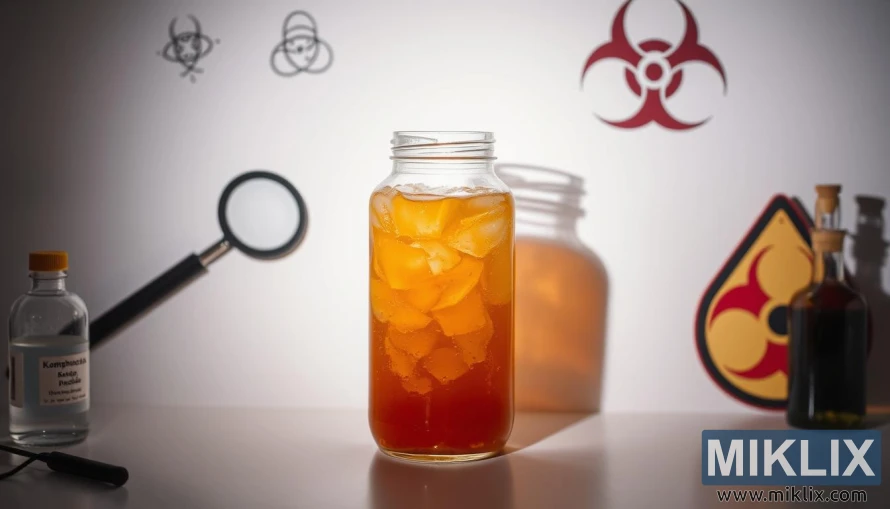Image: Potential risks of kombucha
Published: May 20, 2025 at 11:55:27 AM UTC
Last updated: September 25, 2025 at 8:42:13 PM UTC
Amber kombucha in a jar surrounded by cautionary icons including poison, biohazard, and magnifying glass, symbolizing scientific scrutiny and health risks.
At the center of this stark and thought-provoking composition stands a large glass jar, brimming with an amber-hued liquid chilled by generous chunks of ice. The drink itself glows warmly under the carefully directed side lighting, creating a sharp contrast against the sterile, white background. This illumination emphasizes not only the translucence of the liquid but also the sense of something alive and active within it—an allusion to the fermentative qualities of kombucha. The golden-orange gradient at the base of the jar suggests depth, complexity, and the naturally evolving layers of flavor that kombucha is known for. Yet, despite the visual appeal of the beverage, the scene is layered with undertones of caution, reinforced by the surrounding imagery that places the drink within a context of scrutiny and risk.
On the backdrop loom unmistakable symbols of hazard: the bold, blood-red biohazard emblem, the universal skull-and-crossbones, and other scientific glyphs that carry associations of danger, toxicity, and experimentation. These stark graphics serve as a visual counterpoint to the inviting drink, compelling the viewer to question what might otherwise be taken for granted. To the side, a magnifying glass leans into the frame, almost as if an unseen examiner is in the process of studying the jar with clinical precision. It is a powerful metaphor for the scientific and medical attention kombucha has received over the years—praised by many for its probiotic benefits and detoxifying properties, yet also subject to skepticism, warnings, and reports of potential health risks when improperly brewed or consumed in excess.
Nearby, a small bottle labeled with cautionary text evokes the aura of laboratory specimens or pharmaceutical vials. Its presence shifts the perception of kombucha from a casual health drink into something that must be carefully measured, studied, and perhaps even handled with gloves. Another bottle in the background, darker and more mysterious, enhances this uneasy narrative, as though kombucha’s natural, ancient origins have been recontextualized into a modern experiment requiring oversight and caution. The interplay of these visual elements conveys a dual message: kombucha is simultaneously a beverage rooted in tradition and natural fermentation, and yet, in the wrong conditions, it can be misunderstood, mishandled, or even pose risks.
The shadows cast across the clean surface intensify the drama of the arrangement. The elongated form of the magnifying glass shadow stretches toward the jar, echoing the sense of inquiry, while the jar itself throws a bold silhouette that amplifies its presence in the frame. These shadows create a feeling of tension, as if something hidden might be revealed upon closer inspection. Unlike promotional images that highlight kombucha’s vitality and refreshing qualities, this composition leans into the mysterious and ambiguous territory, where fascination with natural remedies collides with scientific skepticism.
Overall, the atmosphere conjured by this arrangement is one of careful consideration, underscoring kombucha’s paradoxical identity in the modern wellness landscape. It is a beverage with a long history, tied to holistic traditions and celebrated for its probiotic properties, yet also a subject of debate among health professionals regarding safety, purity, and exaggerated claims of miraculous effects. The visual language in the image suggests that kombucha is not simply a refreshing tea-based drink but a complex substance that straddles the line between natural wellness and potential risk. By framing the jar of amber liquid alongside biohazard symbols and tools of examination, the composition reminds viewers that even products celebrated for their natural benefits deserve respect, scrutiny, and a mindful approach to consumption.
The image is related to: Kombucha Culture: How This Fizzy Ferment Boosts Your Health

